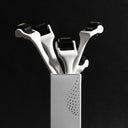Finding effective alternatives to minoxidil is crucial for those who experience side effects or lack results from this popular hair loss treatment.
This article explores various options, from natural remedies to advanced medical treatments, providing solutions tailored to individual needs for regrowing hair.
Table of content
Best Minoxidil alternatives: Quick overview
| Treatment Option | Type | Key Benefits | Possible Side Effects | Considerations |
|---|---|---|---|---|
| Scandinavian Biolabs Hair Growth Routine | Non-invasive treatment | Promotes hair growth with natural ingredients | Minor scalp irritation | Includes serum, shampoo, and conditioner |
| Saw Palmetto | Natural Supplement | Natural DHT blocker | Stomach issues, headache | No prescription needed |
| Ecklonia Cava | Herbal Remedy | Supports hair growth and health | Mild allergic reactions | Derived from seaweed |
| Low-level laser therapy (LLLT) | Non-invasive treatment | Stimulates hair growth | No direct side effects | Requires regular sessions |
| Hair transplant | Surgical | Permanent hair restoration | Scarring, infection | Requires surgery |
| Redensyl | Innovative ingredient | Stimulates hair follicle stem cells | Mild scalp irritation | Non-hormonal |
| Pumpkin Seed Oil | Natural Supplement | Rich in nutrients for hair growth | Mild digestive issues | Anti-inflammatory properties |
| Caffeine | Topical Treatment | Stimulates hair follicles | Skin irritation | Often used in shampoos |
| Rosemary Oil | Natural Treatment | Improves scalp circulation | Allergic reactions | Anti-inflammatory properties |
| PRP (Platelet-Rich Plasma) Therapy | Medical Procedure | Uses body's own healing mechanisms | Mild pain at injection sites | Reduces risk of allergic reactions |
As your leading source for hair health information over the past 4 years, we never compromise on accuracy. When it comes to your health, you deserve information you can truly rely on - and earning your trust is our top priority.
Here's how Scandinavian Biolabs ensures every piece of content meets the highest standards of accuracy and integrity:
- Credentialed Experts: Our reviewers are actively practicing doctors and medical researchers
- Stringent Reviews: Content undergoes rigorous editing by subject specialists and review by a practicing doctor.
- Evidence-Based: We rely on well-established research from trusted scientific sources like peer-reviewed journals and health authorities.
- Full Transparency: Our editorial standards, writer credentials, reviewer credentials, correction process, and funding are all publicly documented.
- Independent Voice: While we do promote products, we operate in a vacuum to business operations. Our main goal is just an unwavering commitment to providing medically-sound guidance.
You can count on Scandinavian Biolabs to consistently deliver the trustworthy health information you deserve. Read our Editorial Standards.
Why should you consider Minoxidil alternatives?
Although studies have shown Minoxidil to be effective for hair loss, it may not work for everyone and can cause side effects like skin irritation and allergic contact dermatitis.
Everyone reacts differently to treatments, so while some people have positive experiences with Minoxidil, others may not see the same results.
If you experience an allergic reaction or don't notice any improvements in your hair loss, it's important to consider alternatives.
Side effects such as skin irritation, allergic contact dermatitis, and temporary Minoxidil-related hair shedding are also common reasons people seek other options.
Exploring different treatments can help you find a solution that works best for your individual needs without the unwanted side effects.
What Minoxidil alternatives are there?
Here are the top 10 alternatives to minoxidil:
- Scandinavian Biolabs Hair Growth Routine
- Dutasteride
- Finasteride (Propecia)
- Rosemary Oil
- PRP (Platelet-Rich Plasma) Therapy
- Hair Transplant Surgery
- Redensyl
- Pumpkin Seed Oil
- Caffeine
- Low-Level Laser Therapy (LLLT)
1. Scandinavian Biolabs Hair Growth Routine

Instead of relying on a single active, Bio-Pilixin combines several ingredients backed by clinical studies. Biotin strengthens follicles while caffeine has been shown to stimulate dormant hair growth. Other plant extracts provide essential scalp nutrients in studies.
Where some treatments focus only on circulation or stimulation, Bio-Pilixin addresses multiple aspects of the hair growth cycle. It nourishes the scalp environment and supports existing hair strands from within.
Here are the key clinical findings of the study, as reported by researchers after 150 days of usage:
- 93.3% of volunteers showed a reduction in hair loss. The average hair loss reduction was 45.75%, with a maximum hair loss reduction of 85.08% (volunteer 26)
- 73.3% of volunteers showed a significant improvement in hair density. Capillary density increased by up to 23.31% after the usage.
- 17.5% increase in the number of hair in the anagen (growth) phase after 150 days. 36.5% decrease in the number of hair in the telogen (rest) phase after usage.
- 80% of volunteers reported a moderate-to-intense hair loss reduction.
- 93.3% of volunteers reported being satisfied with the hair loss usage.

Importantly, Bio-Pilixin's formula is free of unnecessary chemicals like parabens, sulfates and other potential irritants. This sets it apart in terms of long-term scalp compatibility and sustainability of results.
While no product is right for everyone, Bio-Pilixin's holistic system and added research into its optimally-dosed ingredients position it as a top contender for those seeking an alternative to minoxidil.
A 150-day money back guarantee offers the opportunity to experience its benefits firsthand and determine if it could be right for regaining your hair's full thickness and health.-
2. Dutasteride
Dutasteride is an advanced oral medication used primarily for male pattern baldness. It works by inhibiting the conversion of testosterone into dihydrotestosterone (DHT), the hormone primarily responsible for male pattern hair loss.
Clinical studies have demonstrated that Dutasteride is more potent than Finasteride, another DHT blocker, leading to more significant improvements in hair density and thickness.
However, its powerful action means it also carries a risk of side effects, particularly affecting sexual function. It's a prescription medication, reflecting its potency and the need for medical supervision during its use.
3. Finasteride (Propecia)
Minoxidil is often touted as the first alternative to finasteride. Consequently, finasteride is also an alternative to minoxidil.
Finasteride, marketed as Propecia, is one of the most well-known oral medications for male pattern hair loss. It operates similarly to Dutasteride by inhibiting DHT.
Numerous clinical trials have validated its effectiveness, with a significant number of male participants reporting a halt in hair loss and noticeable hair regrowth. Finasteride’s long-standing presence in the market is backed by a substantial body of research, making it a reliable choice for men.
However, its use is associated with potential side effects, including sexual dysfunction, and it is not recommended for women due to risks during pregnancy.
4. Rosemary Oil
Rosemary oil has garnered attention as a natural remedy for hair growth. Studies comparing its effectiveness to Minoxidil have shown promising results. It's thought to improve blood circulation to the scalp, which is vital for healthy hair growth.
Moreover, its anti-inflammatory and antioxidant properties can contribute to a healthier scalp environment, potentially reducing issues like dandruff and scalp irritation.
While the scientific evidence supporting rosemary oil is not as robust as for pharmaceutical treatments, its safety profile and ease of use make it an attractive option for those seeking a natural remedy.
5. PRP (Platelet-Rich Plasma) Therapy
Platelet-Rich Plasma (PRP) Therapy is an advanced hair loss treatment that involves extracting a patient's own blood, processing it to concentrate the platelets, and then injecting it into the scalp.
The concentrated platelets release growth factors that stimulate and increase the number of reparative cells your body produces. Several studies have demonstrated the efficacy of PRP in hair regrowth, noting improvements in hair density and stimulation of dormant follicles.
This method is particularly appealing because it's a natural process using the body's own healing mechanisms, reducing the risk of allergic reactions or side effects.
6. Hair Transplant Surgery
Hair transplant surgery is a permanent solution for hair loss, involving the transplantation of hair follicles from one part of the scalp (usually the back or sides, where hair is denser) to the thinning or balding areas.
This procedure is highly effective for restoring hair and can provide natural-looking results. Research shows that modern hair transplant techniques like Follicular Unit Extraction (FUE) and Follicular Unit Transplantation (FUT) offer high success rates.
However, it's important to have realistic expectations and understand that the outcome depends on factors like the extent of hair loss and the density of the donor area.
7. Redensyl
Redensyl is an innovative ingredient in hair loss treatment that targets hair follicle stem cells to encourage hair growth. It combines two patented molecules, DHQG and EGCG2, which aim to reactivate hair growth and reduce hair fall.
Early clinical studies have shown promising results, with a significant increase in hair growth and a reduction in hair loss noted in several trials.
While Redensyl is still relatively new to the market, its non-hormonal nature and suitability for both men and women make it an appealing alternative to traditional hair loss treatments.
8. Pumpkin Seed Oil
Pumpkin seed oil is rich in nutrients like zinc, magnesium, and fatty acids, which are thought to be beneficial for hair growth.
Preliminary studies suggest that it can help treat hair loss, particularly when used as a supplement. Its anti-inflammatory properties might also contribute to a healthier scalp environment.
While the scientific evidence is not as extensive as for more established treatments, the safety profile and potential health benefits of pumpkin seed oil make it a popular choice for those interested in natural hair growth supplements.
9. Caffeine
Caffeine has been studied for its potential to stimulate hair follicles and promote hair growth. It's thought to extend the life cycle of hair follicles and stimulate hair shaft elongation, resulting in thicker, longer hair.
Studies have shown that caffeine can counteract the negative effects of testosterone on hair growth, making it particularly effective for androgenetic alopecia.
Caffeine is often used in shampoos and topical treatments, making it an easy and accessible way to potentially boost hair growth.
10. Low-Level Laser Therapy (LLLT)
Low-level laser therapy, also known as LLLT or red light therapy, is a non-invasive treatment for hair loss that utilizes low-level lasers or light-emitting diodes (LEDs) to stimulate hair follicles and promote hair growth.
This therapy is based on the concept that specific wavelengths of light can increase blood flow to the scalp, reduce inflammation, and energize dormant hair follicles.
LLLT devices come in various forms, including laser caps, helmets, combs, and brushes, making it easy for individuals to use at home.
Conclusion
In conclusion, while Minoxidil is effective for many, it may not work for everyone and can cause side effects.
Fortunately, there are several alternatives. Scandinavian Biolabs Hair Growth Routine, Dutasteride, and Finasteride offer potent solutions. Natural remedies like rosemary oil, pumpkin seed oil, and caffeine are gentler options.
Advanced treatments such as PRP therapy, hair transplant surgery, and LLLT use cutting-edge techniques.
Each alternative offers unique benefits, allowing you to choose a solution tailored to your needs.







